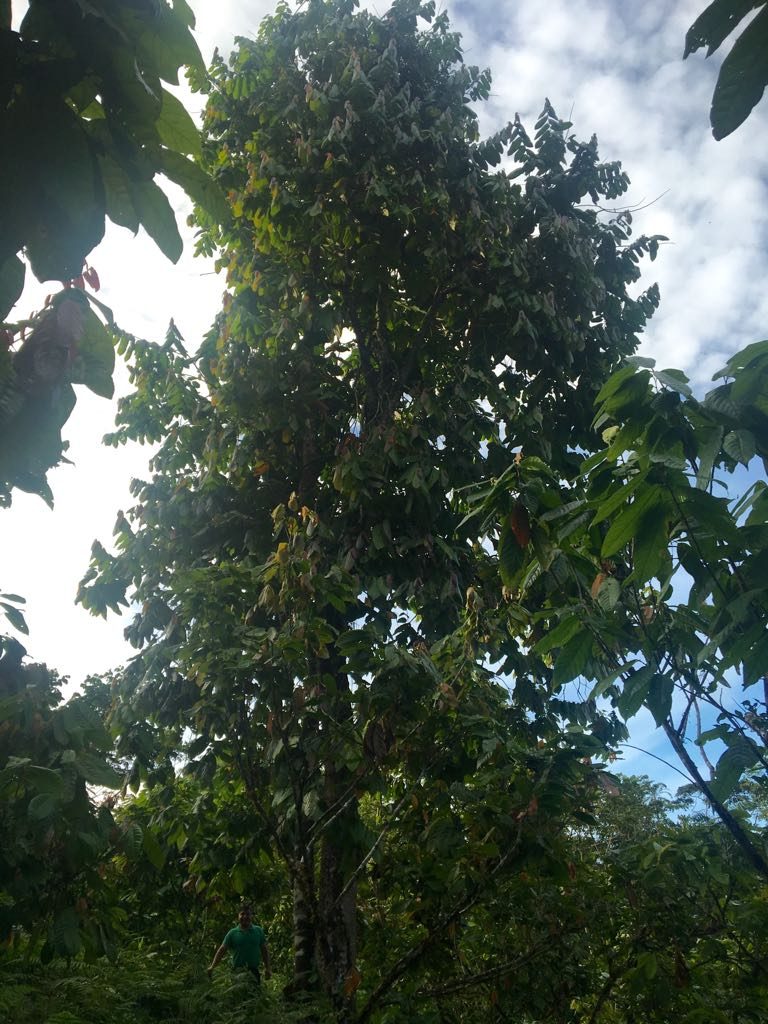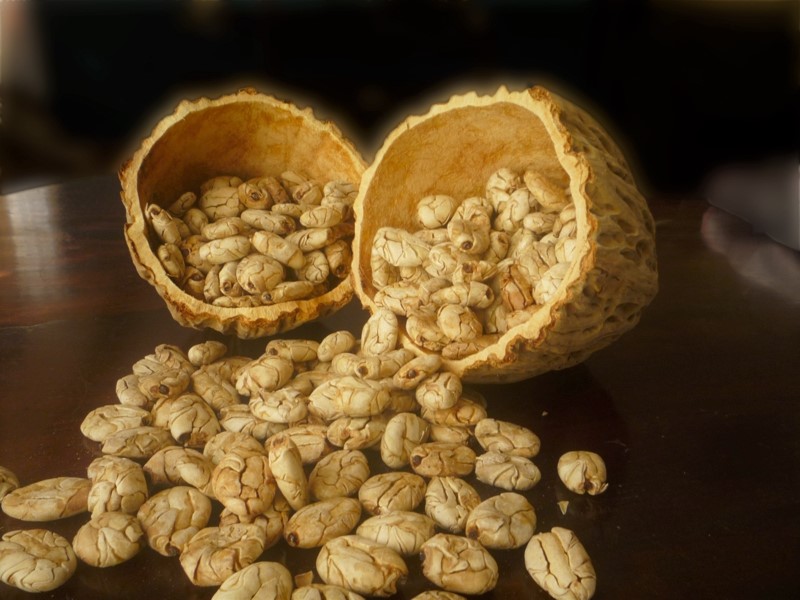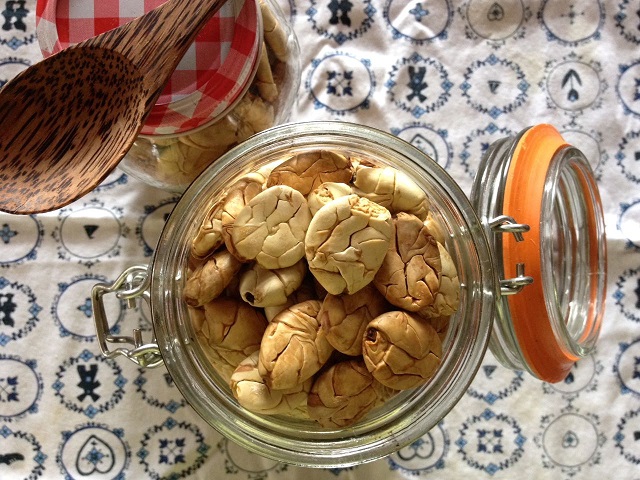By Jacob Olander
Chocolate may be heavenly, but macambo seeds – from a cousin of the cacao tree – may be the most exciting rainforest superfood that you’ve never heard of. Macambo packs a hefty dose of protein, fiber and antioxidants into a delicious, crunchy nut-like package.
Theobroma literally means “food of the gods,” and is the scientific name of the group of plant species that brings us chocolate. And while cacao (Theobroma cacao), from which chocolate is made, is far more famous, macambo (Theobroma bicolor), cultivated by indigenous farmers of the Amazon in Peru, Ecuador and Colombia, deserves to be more widely known.
A handful of about 10 of the lima bean-sized seeds provides 7 grams of protein and 9 grams of fiber, which correspond to 14% of the protein and 37% of the fiber of an adult’s total daily requirements. At about 24% by weight, macambo beans pack in more protein than almonds, walnuts or cashews, and the fact that they´re loaded with fiber means it can contribute to improved digestion, cholesterol regulation and stabilizing blood sugar levels. Combined with high levels of Omega-9 (11.5%) and antioxidants, it’s perhaps not surprising that macambo has long been an important part of the diet of some Amazon indigenous groups, providing them with a powerful nutritious boost.
And it’s delicious. On an expedition to the Peruvian Amazon we organized with leading chefs, it was singled out as one of the most promising local ingredients: “Toasted, it becomes a delicate and very crunchy nut – a handful of macambo seeds and good champagne: a luxury!” says Mara Salles chef of Sao Paolo’s Tordesilhas Restaurant.
Tasty and snackable. Nutrient-dense. High protein. Fiber-rich. Antioxidant. Vegan. Paleo. Organic. And with deep roots in indigenous rainforest culture and nutrition. It seems like macambo has everything going for it to make it a blockbuster product. So why have so few people heard about it, even in the countries it comes from?
Why aren’t we eating (and growing) more macambo?
Nowadays production of macambo is very limited – typically just a handful of trees are found mixed into some Amazon forest gardens, which to the untrained eye look more like forests than farms. Most macambo is consumed locally, and overall farmers in Ecuador and Peru we’ve talked to don’t give much thought to their trees, because there´s not much of a market.
Though it´s not uncommon to find macambo roasted on skewers by street vendors in cities like Iquitos and Tarapoto in Peru, its place in traditional diets seems to be dwindling as people turn to introduced and processed foodstuffs. Too bad, because a few more macambo trees integrated into a farmer’s diverse plots could in principle make a big difference in family income, could add a nutritious new rainforest food to both Western and local diets, and help sustain hyper-diverse farming systems that maintain rainforest biodiversity.
We´ve figured that for a small farmer with a 1-2 hectare agroforestry plot, adding in 20-30 macambo trees could generate USD 300 – USD 500 per year. And macambo can grow pretty much anywhere cacao does, meaning it could be a complementary source of income for thousands of farmers in Latin America, hedging in part against the seesawing prices of this global commodity.

But without a market, there´s limited interest in growing a tree that takes 3-6 years to produce – and of course, without supply, it´s hard to build a market. Like with many promising tropical species, there´s a fine balancing act between building supply and demand in ways that work for everyone involved in the market. But some startups are working on it.
Coming to America
A few suppliers have started making macambo available in the United States. One is Eco Ola, a Peruvian based firm that exports macambo beans through a company called Imlak´esh Organics located in California. Founded in 2009, Eco Ola commercializes Amazonian superfoods with the mission of delivering nutritious foods while preserving the biodiversity of the rainforest and improving the lives of farmers. They´ve identified macambo as a product that could fit this model well.
William Park, co-founder of Eco Ola explains that “macambo is not only a very nutritious fruit with seeds that can be exported and sold in health stores, but its tree also plays an important role in agroforestry systems.” Macambo trees can be combined easily with other species to create symbiotic agricultural systems. “Tall macambo trees provide shade for smaller species like coffee and the dwarf varieties that tolerate shade can be combined with bigger trees” explains Bill.
Additionally, putting macambo beans in the market allows farmers to diversify their income. Women from 20 families in 5 communities of Loreto, the northern Peruvian Amazon, are in charge of processing the fruit to obtain the roasted beans that are sold in the United States. “We train women in the communities and provide them with equipment to process macambo so that we can pay a higher price for a value-added product” Bill emphasizes.
Some chocolate makers have explored ways to use this underappreciated cousin of cacao. At least one company, Chocosol, has used macambo beans to make chocolate (or a chocolate-like product to be precise). And other specialty chocolate makers have shown interest in integrating macambo pieces to add a nut-like crunch to their bars.
In Quito, where Canopy Bridge is based, we´ve been bringing macambo (known here as patasmuyo) from Kichwa farmers to chefs and high-end restaurants as part of our rainforest-to-table initiative, Cumarí.
Poised to grow
With all that macambo has going for it – for health-focused consumers and for the rainforest communities that cultivate it – it’ll be no surprise if this forgotten food of the gods takes off soon.
Featured photo: ámaZ restaurant, where macambo is being used as a specialty ingredient to add texture and flavor to a variety of dishes.
Recommended readings:
Shortening the Distance to the World of Sustainable Gastronomy




I luv Macambo and Sacha Inchi seed for the best snacks ever!
Good afternoon, we are a farmers family producing some bars with Theobroma Cacau, Bicolor and Grandiflorum. We are having dificulties to find Nutritional facts about the Bicolor (Macambo) and would very much apreciate to have the nutriotional facts of Macambo to put on our products.
I was very happy to find out, that there are more people producing and comercializing macambo.
Regards
Gudrun